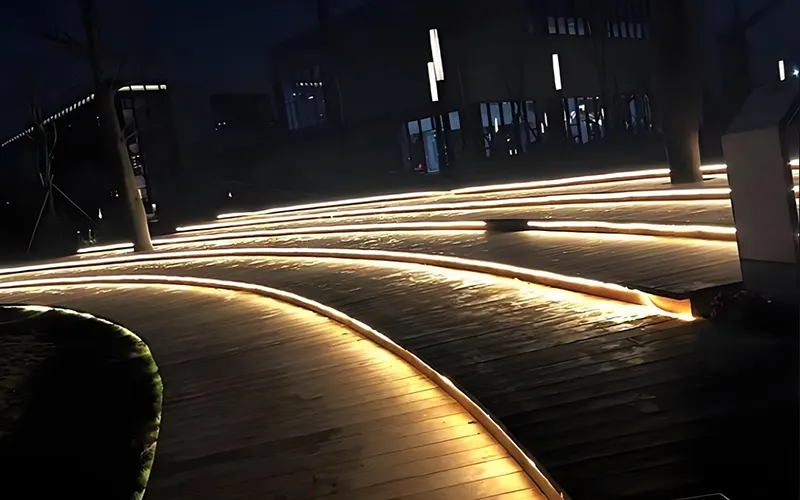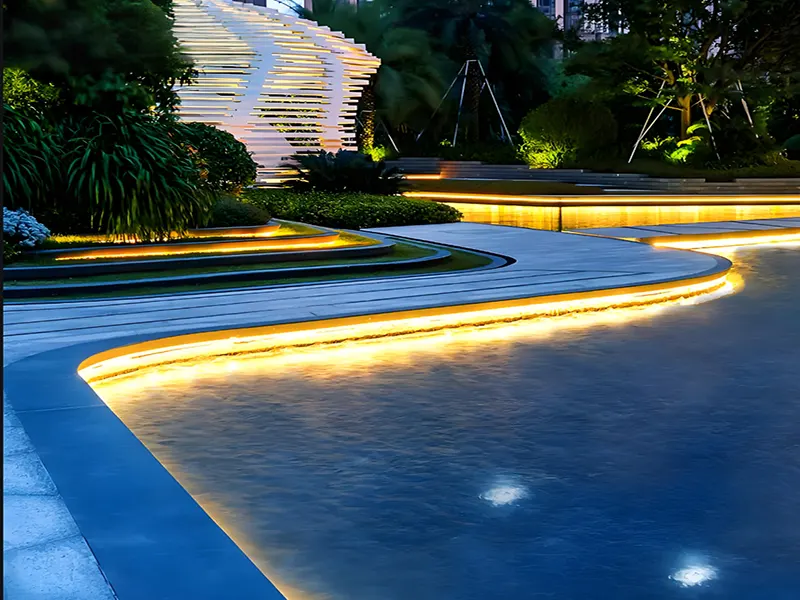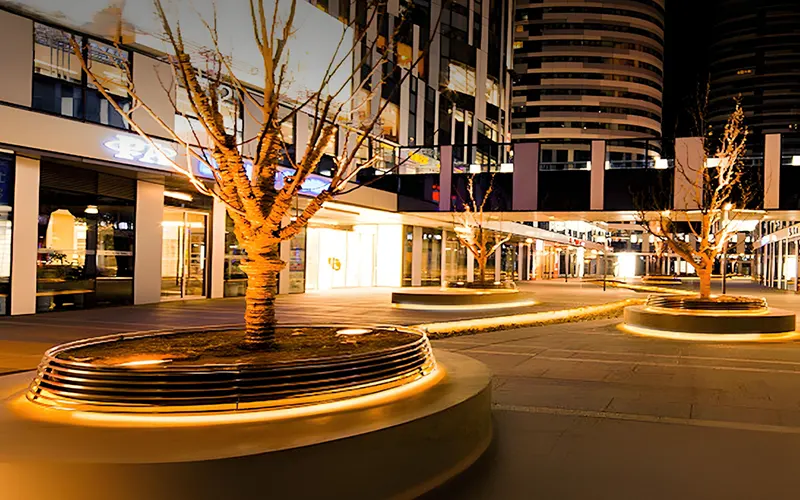The effect of outdoor waterproof LED strip lights is not only to improve nighttime lighting and safety. It can also add a sense of atmosphere to courtyards, terraces, building exteriors, etc. The outdoor environment is complex and changeable, and ordinary LED light strips are prone to moisture, dust, and even short circuits. Therefore, it is crucial to choose a truly waterproof, durable, and compliant LED light strip.
Compared with indoor LED strips lights, outdoor applications face more challenges. Mainly rainy and humid places, including severe weather conditions, temperature changes, ultraviolet radiation, and mechanical shock.
Therefore, when choosing outdoor LED light strips, it is essential to comprehensively consider multiple factors, including waterproof performance, protection level, voltage selection, color brightness, and installation method.
This article will introduce the key points and installation methods of outdoor waterproof LED strip lights in detail to help you make a wise choice and ensure that the light strips work safely and stably outdoors for a long time.
What Kind of Waterproof LED Strip Lights can Be Used Outdoor?
Waterproof LED light strips are commonly used outdoor lighting fixtures. This type of light strip usually uses silicone sleeve packaging or epoxy resin potting technology to form an effective protective barrier on the LED chip, circuit board and connection parts. More information, pls read 6 Different Ways to LED Strips Light Waterproof

Only LED strip lights with a waterproof rating of IP65 or above can be used outdoors. The most common waterproof treatment method, transparent or translucent silicone materials not only have excellent waterproof performance, but also effectively resist ultraviolet erosion and prevent material aging and yellowing.
In addition, outdoor waterproof LED strip lights also have good temperature adaptability, and the operating temperature range is usually between -20°C and 60°C, which can withstand seasonal temperature changes.
At the same time, high-quality waterproof LED light strips also have pressure resistance, because they may also have to withstand human trampling and a certain degree of impact.
How to Distinguish the IP Level of Outdoor Waterproof LED Strip Lights?
The IP protection level is an important indicator to measure the dust and water resistance of electrical equipment. For outdoor LED light strips, it is crucial to choose the right IP protection level. How to choose the waterproof strip, pls check What are the Different Types of Waterproof Light Strips?
The IP protection level consists of two numbers. You first look at the first number 6, which indicates dust resistance, and the second number indicates water resistance. The larger the number, the stronger the protection.
For example, the lowest waterproof level IP65 means that the device is completely dustproof and water-proof. The highest level of waterproof IP68 means that the device can be immersed in a certain depth of water for a long time without being damaged.
How to Choose the Voltage and Color Temperature of Outdoor Waterproof LED Strip Lights?
For outdoor waterproof LED strip light, in addition to the waterproof level, there are two important factors to consider, that is, voltage and color temperature.

Voltage
The voltage selection of outdoor LED light strips directly affects safety and installation costs. Common voltage specifications include 12V, 24V and 230V direct power supply.
If you install waterproof LED light strips outdoors, we recommend using low-voltage LED lights and. Therefore, 12V and 24V light strips are safe choices, especially for home users and humid environments.
Even if accidental contact occurs, 12V and 24V voltages will not cause harm to the human body. This voltage specification is usually used for small decorative projects, garden lighting or children’s activity areas. At the same time, it maintains relatively high safety.
The 230V directly powered LED light strip is easy to install and does not require an additional transformer, which is suitable for large commercial projects. However, the 230V system must be installed by a professional electrician and requires strict safety measures and grounding protection.
Color and brightness
The color and brightness of outdoor waterproof LED strip lights directly affect the lighting effect. In terms of color, there are two common types: monochrome (such as red, green, blue, white, etc.) and RGB full color.
Monochrome light strips are suitable for creating simple and clear lighting effects, while RGB full color light strips can achieve rich color changes to meet the lighting needs in different scenes.
RGB full color light strips are more used for beautification and decoration of outdoor buildings, and the effect of changes is very good, especially SPI and DMX512 waterproof light strips.
Decorative lighting usually uses lower brightness (300-600 lumens/m), while functional lighting may require higher brightness (1000-1200 lumens/m). Too high brightness not only increases energy consumption, but also may cause light pollution.
What Materials Should Outdoor Waterproof LED Strip Lights Be Installed On?
The choice of installation materials directly affects the fixing effect and service life of LED light strips. Different materials have different characteristics, so when installing waterproof LED light strips, you need to pay attention to the material. The corresponding installation method and fixing materials need to be adopted.

Concrete and masonry surfaces
When installing LED strips on these materials, expansion bolts are usually used to ensure a firm connection. It should be noted that when drilling holes, damage to the building structure should be avoided, especially when installing on load-bearing walls.
Wood surfaces
Wood surfaces are relatively simple to install, and the mounting clips can be fixed with self-tapping screws or wood screws. However, wood is easily deformed by moisture, so it is necessary to choose wood that has been treated with anti-corrosion, and reserve appropriate expansion space during installation.
Metal surfaces
For metal surfaces, installation needs to consider the effects of thermal expansion and contraction, especially in areas with large temperature differences. Stainless steel and aluminum alloys are ideal choices with good corrosion resistance and stability.
Plastic and composite surfaces
These materials require special attention to the material’s load-bearing capacity and temperature stability. Some plastic materials become brittle at low temperatures and soften at high temperatures, affecting the fixing effect. Choosing high-quality engineering plastics or fiber-reinforced composites can provide better performance.
Glass surfaces
Then we usually use special adhesives or suction cup fixings. You need to make sure the glass surface is clean and dry and choose the right type of adhesive. Transparent or translucent fixing materials can maintain the beauty of the glass.
Precautions for Outdoor Waterproof LED Strip Lights Installation
The correct installation method is the key to ensure the long-term stable operation of outdoor LED light strips. The power adapter or driver should be installed in a rainproof location, such as in a distribution box or a dedicated protective cover.
All electrical connections must use waterproof connectors and be properly sealed. Grounding protection is a basic requirement for safety, especially when using a 220V system.
For buckle fixing, a suitable fixing spacing should be selected, usually setting a fixing point every 30-50 cm. Generally, buckles and LED aluminum profiles are required for fixing, because LED waterproof light strips are a bit heavy. If it is only installed with 3M glue, it will fall off in the long run.
Conclusion
When we choose the right outdoor waterpoof LED strip lights, we need to consider waterproof characteristics, IP protection level, voltage selection, color and brightness, installation location and material, and installation method.
For more waterproof LED strip lights, please consult us. There is also an IP68 neon tube that can be used in swimming pools and underwater, you can check it out.
FAQs
Not necessarily. The outdoor LED light strips need to depend on the environment. If it is used in swimming pools and underwater, then you must choose an IP68 waterproof LED light strip. If it is only installed in places that are not directly exposed to water, such as eaves and balconies, IP65 or IP67 is sufficient.
Yes, as long as the IP rating of the light strip reaches IP65 or above. If the rating is above IP65, it can effectively prevent rainwater from seeping in.
Most waterproof LED light strips can be cut according to the marked position, but the original waterproof structure will be destroyed after cutting. So after you cut it, you need to use special waterproof joints and sealants, or reseal the joint position to ensure that it does not seep water.
Yes, our products are silicone waterproof LED strips encapsulated with UV-resistant materials. They can be used outdoors for a long time without yellowing, cracking or hardening.
Yes, you just need to choose the right waterproof level. At least IP65 waterproof level or above.
